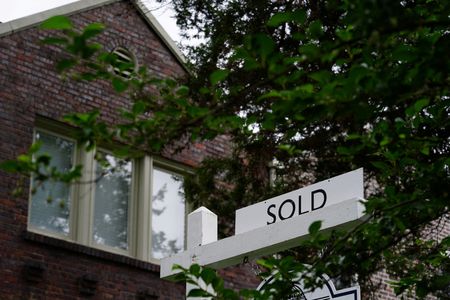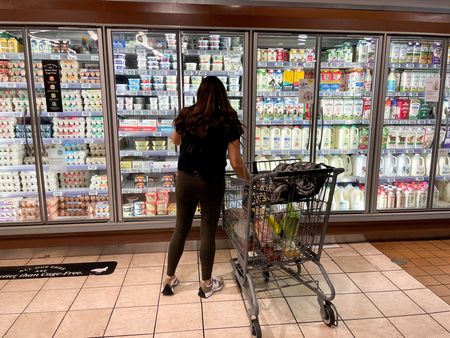By Lucia Mutikani
WASHINGTON (Reuters) – U.S. consumer confidence ebbed in October after two straight monthly increases amid rising concerns about inflation and a possible recession next year, but households remained keen to purchase big-ticket items like motor vehicles and appliances.
The Conference Board survey on Tuesday also showed more consumers planned to buy a home over the next six months, despite soaring borrowing costs. The steady rise in consumers’ buying intentions could provide some stability for the economy in the near-term.
But there are signs that the Federal Reserve’s aggressive interest rate hikes are starting to cool the labor market, with a decline in the share of consumers viewing jobs as “plentiful” and a rise in those saying employment was “hard to get.”
“The biggest risk is the unknown lagged effects from the Fed’s cumulative tightening and the economy may not feel the full effects until next year when recession risks are high,” said Jeffrey Roach, chief economist at LPL Financial in Charlotte, North Carolina.
The Conference Board’s consumer confidence index fell to 102.5 this month from 107.8 in September. Economists polled by Reuters had forecast the index at 106.5. The decline in confidence was across all age groups, but more pronounced in the 35-54 and well as the 55 and over cohorts.
Regionally, there were marked decreases in Florida, probably because of Hurricane Ian, and Ohio. Consumers’ 12-month inflation expectations rose to 7.0%, likely reflecting a recent reversal in gasoline prices after falling over the summer, from 6.8% last month. Food also remains very expensive.
Stubbornly high inflation and fading confidence are a blow to President Joe Biden and Democrats’ hopes of retaining control of Congress in Nov. 8 mid-term elections.
The Fed, fighting the fastest-rising inflation in 40 years, has raised its benchmark overnight interest rate from near zero in March to the current range of 3.00% to 3.25%, the swiftest pace of policy tightening in a generation or more. That rate is likely to end the year in the mid-4% range, based on the U.S. central bank officials’ own projections and recent comments.
The survey’s present situation index, based on consumers’ assessment of current business and labor market conditions, tumbled to 138.9, the lowest level since April 2021, from 150.2 in September.
Its expectations index, based on consumers’ short-term outlook for income, business and labor market conditions, fell to 78.1 from 79.5 last month. The expectations index remains below a reading of 80, a level associated with a recession and suggests that the risks of a downturn could be rising.
The survey’s so-called labor market differential, derived from data on respondents’ views on whether jobs are plentiful or hard to get, dropped to 32.5, the lowest reading since April 2021, from 38.1 in September.
This measure correlates to the unemployment rate from the Labor Department and is still high by historical standards. Unemployment benefits data show the labor market remains tight.
Stocks on Wall Street were trading higher. The dollar fell against a basket of currencies. U.S. Treasury prices rose.
SPENDING PLANS RISE
Even as consumers worried about the economy’s outlook, they remained interested in buying big-ticket items over the next six months, though they pulled back on travel plans, suggesting many Americans intended to stay home over the holiday season.
The share of consumers planning to buy motor vehicles increased to the highest level since July 2020. More consumers planned to buy appliances such as refrigerators, washing machines and vacuum cleaners.
“Consumers have abundant excess saving and they are willing to dig into this pile of cash to keep their real spending at least stable, even as inflation eats into their real incomes,” said Scott Hoyt, senior economist at Moody’s Analytics in West Chester, Pennsylvania.
Consumers were also more inclined to buy a house, probably encouraged by a sharp slowdown in house price inflation.
But surging mortgage rates remain an obstacle. The 30-year fixed mortgage rate averaged 6.94% last week, the highest in 20 years, up from 6.92% in the prior week, according to data from mortgage finance agency Freddie Mac.
A separate report on Tuesday showed the S&P CoreLogic Case-Shiller national home price index increased 13.0% year-on-year in August after advancing 15.6% in July. On a monthly basis, prices fell 0.9% in August, the second straight monthly drop.
A third report from the Federal Housing Finance Agency showed home prices increased 11.9% in the 12 months through August after rising 13.9% in July. Prices fell 0.7% on a monthly basis after decreasing 0.6% in July. It was the first time since March 2011 that monthly prices posted back-to-back declines.
“We expect home price inflation to slow in the remainder of 2022, falling to single digits by year-end and to zero by the second quarter of 2023,” said Nancy Vanden Houten, lead U.S. economist at Oxford Economics in New York. “With home sales falling as deteriorating affordability sidelines many buyers, prices will have to adjust. However, inventory remains low, and we think that will keep a floor under home prices.”
(Reporting by Lucia Mutikani; Editing by Chizu Nomiyama and Andrea Ricci)


